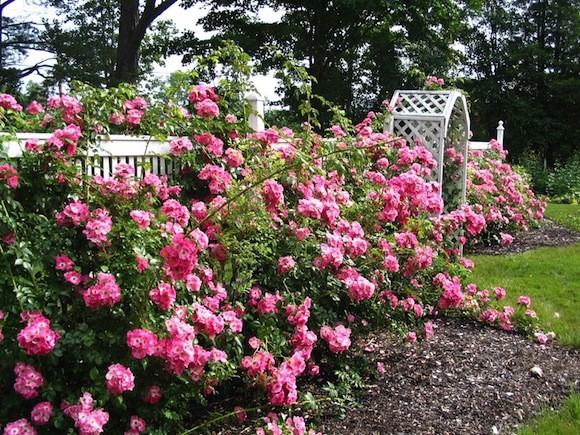 Looking after your Roses By Paul McLaughlin, Ballaghdearg Garden Centre
Looking after your Roses By Paul McLaughlin, Ballaghdearg Garden Centre
At this time of year there are few sights as striking or as memorable as a garden full of brightly coloured rose blooms. Like many other plants in the garden, the more time you devote to your roses the more likely they are to reward you with a bright summer display. While roses are very easy plants to grow, to get the best out of them they do require a certain amount of care throughout the year. This care includes pruning in the winter and early spring, feeding from the start of the growing season, dead-heading and regular spraying for insect and fungal infection.
To set them up for the flowering season, all roses need a good feed at this time of year. While pretty much any general purpose fertilizer will show results, it is worth investing in one of the specialist rose fertilizers such as “Top Rose” which are widely available from garden centres. These fertilizers have been specially blended for roses and contain the correct ratios of nitrogen, potash and trace elements to promote both strong foliage and healthy flowers. These fertilizers usually come in granular form and a small handful should be sprinkled around each rose and then lightly raked into the soil. This top dressing can be repeated in July to extend the flowering season.
Throughout the flowering season roses should also be regularly dead-headed. Dead-heading is the removal of faded flower heads from the plant to prevent it from producing seeds. If a faded bloom is not removed and the rose is allowed to produce seeds, much of the plants growing strength will be diverted away from flower production. When dead-heading roses it is important not to just pull off the dying flower but to cut the stem on which the flower has grown back by about a third to allow a new bloom to develop quickly.
Throughout the flowering season roses also have to be sprayed regularly to combat both insect and fungal infection. While you can reduce the amount of spraying needed by planting roses with a high resistance level to disease, almost all roses are vulnerable to some form of pest or disease. The only effective way to deal with these problems is through a regular spraying program. While opinions differ on what is the best spray to use, pretty much any specialist rose spray will combine the right amounts of fungicide and insecticide to keep your roses healthy. No matter what you are spraying your roses with there are a few general rules which should be followed. Most importantly always follow the manufacturer’s directions very carefully, wear the correct protective clothing such as a mask and gloves and always be sure to use enough spray to wet both sides of the leaves as the underside is often where pests do the most harm.
Below is a list of the most common problems to effect roses and how to identify and deal with them;
Blackspot
This fungus shows up as round black spots on the leaves, usually towards the end of June or early July. If neglected this fungus will spread rapidly, turning the rest of the leaf yellow and causing it to fall off. To combat blackspot roses should be sprayed every 10-14 days with a suitable fungicide and all infected leaves should be removed from the area and destroyed.
Mildew
This is a grey powdery looking covering which is usually seen on young leaves and stems. Mildew will spread rapidly through a plant, and while it is not fatal it is very unsightly. Once again spray with a suitable fungicide at the first sign of infection.
Aphids and Greenfly
These are tiny insects that gather on young leaves and flower stems to feed on the plants sap. These insects weaken plants and spread with incredible speed. While there are a number of theories on how best to remove greenfly, the most effective way seems to be with regular spraying with a suitable insecticide.
* Want more information? Call in and see me at our garden centre today.
Any questions: email me on info@highlandlandscapes.ie
Tags:







